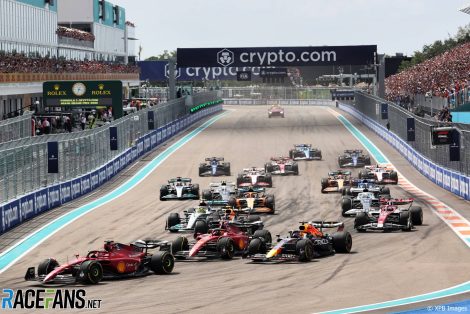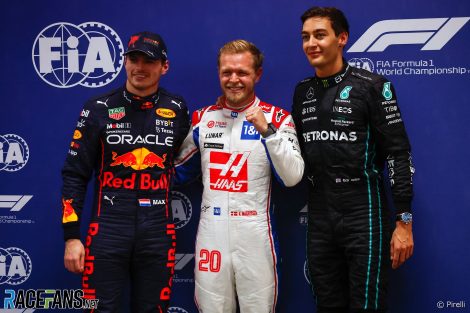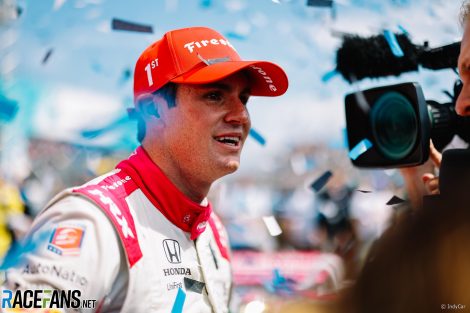Any Formula 1 fanatics who have spent recent years agonising over the so-called ‘Americanisation’ of their favourite sport wouldn’t have had their anxieties calmed by Liberty Media CEO Greg Maffei’s comments during a meeting with investors last week.
Maffei hailed the various actions Liberty had taken with F1 and the FIA to modify the sport – such as introducing the budget cap, making prize money pay-outs more even across the championship and transforming technical regulations with ground effect cars. But he also casually mentioned that he and F1 CEO Stefano Domenicali had caught up over lunch to swap notes with two of the most powerful figures in North American sport: NFL commissioner Roger Goodell and NBA commissioner Adam Silver.
And it’s clear that the NFL – the most lucrative sports league in North America and, indeed, on planet Earth – is the model Liberty aims to emulate with F1.
“Our goal is to build a long-term healthy ecosystem and build a sport that has as much of some of the elements that the NFL has on any given Sunday – that anybody can win,” Maffei said during the investors call. “They compete like hell on Sunday and then think about the league first on Monday.”

Anyone familiar with American football will know the ‘any given Sunday’ mantra is more than just the title of an Oliver Stone movie but a core element of the NFL’s ethos and appeal. It’s the idea that, no matter how wide the gulf in ability between two opposing teams, the nature of the gridiron means fans can always head to a game knowing their team has a chance to take home a victory.
There was perhaps no greater example of this than Super Bowl 42 in 2008, when the all-or-nothing championship showdown pitted the unstoppable New England Patriots, looking to become the first team to win all 19 games in a single season, against a New York Giants team who had somehow stumbled into the showdown having lost almost 40% of their regular season ties. Through disciplined defence, a hard-nosed effort from their attacking core and perhaps the most exceptional act of athleticism in Super Bowl history, the Giants overcame the odds and pulled off one of the greatest upsets in North American sporting history to become champions. The Patriots’ quest for a perfect season ended at the last.
But as thrilling a story as the Giants’ own giant-killing performance was, how does it relate to Formula 1? After all, a grand prix is never just two teams pitted in direct competition against each other. Rather, there are ten teams competing at the same time – 20 drivers all fighting among themselves to be the sole winner to reach the chequered flag first.
Advert | Become a RaceFans supporter and
At the heart of the matter is predictability. When you have seasons like 2004 with Michael Schumacher, 2011 with Sebastian Vettel, 2019 with Lewis Hamilton or even last season with Max Verstappen, it’s nearly impossible for fans to approach a race weekend with hope that the runaway championship leader will face competition for victory. This problem has worsened during the V6 turbo era.

In the nine full seasons since the current power unit formula began only two teams – Mercedes and Red Bull – have claimed the championship silverware. The three most successful teams of the era – Mercedes, Red Bull and Ferrari, took 178 of the available victories over the 182 races – a rate of 97.8%. Teams outside of that exclusive club only took victories a total of four times – AlphaTauri, Racing Point, Alpine and McLaren all claiming a single win each.
Even outside of the top step of the podium to the other two alongside, the rate hardly gets any better. The top three teams hoarded 91.4% of the 539 podium places between 2014 and the end of 2022, meaning you could pick any of the 182 grands prix in that span and have less than a one-in-ten chance of finding a driver not from the top three teams on the podium.
When lightning does eventually strike and an unexpected winner takes the chequered flag on those very rare occasions, it’s almost entirely through circumstance and good fortune – not through pure merit. Pierre Gasly and Esteban Ocon fully earned their shock race wins by holding their nerves in the lead, but both required exceptional good luck to find themselves out front to begin with. Even McLaren’s one-two victory at Monza in 2021, achieved through excellent driving by both Daniel Ricciardo and Lando Norris, might not have happened had Verstappen and Hamilton not collided.
What Formula 1 too often lacks is that potential for teams to somehow hook their cars up out of the blue and storm to victory through virtue of simply being the fastest at that particular track on that particular weekend. Just this past weekend, IndyCar provided the perfect example as second-year driver Kyle Kirkwood – who had only recorded a single top-10 finish before Sunday’s Grand Prix of Long Beach – converted pole position into a stunning first victory in the series.
Advert | Become a RaceFans supporter and
Yes, Kirkwood’s form was boosted by his move from AJ Foyt’s team to the better-resourced Andretti powerhouse. But having those opportunities to fight at the front when you get your car in the perfect window is what F1 refugees like reigning Indianapolis 500 winner Marcus Ericsson find so appealing about racing in America’s foremost single-seater series.

“I think that was one of the biggest motivations for me coming over to IndyCar,” Ericsson said after taking third place on Sunday. “To get the chance to sort of show what I could do on top-level racing.
“The IndyCar championship, the competitiveness of the championship, especially this year, is just incredible. There’s so many good drivers and cars out there. To know every weekend you can go out and compete and fight for a win, the kind of drive you get from that is something I missed very much in my five years in Formula 1.”
Of course, as IndyCar is largely a single-spec series, you would expect it to be more competitive than Formula 1, where teams design, build and develop their cars each season. But as Liberty Media look to emulate that ‘any given Sunday’ dynamic of the NFL, they’re also unknowingly looking to revive competition in Formula 1 to the level it was at times during the eighties and nineties – a period many long-time fans consider the peak of the sport.
Back then, the strongest teams still took the lion’s share of victories. But the smaller teams further down the field still knew that if they played their cards right, they had just as much chance of points or better as any of their rivals. Across the whole of the 1980s, an average of 7.8 teams a year scored at least one podium during the season. In the last full decade – 2010 to 2019 – that figure dropped to an average of only five teams a season.
Advert | Become a RaceFans supporter and
Although 2023 is hardly proving the most competitive start to a season in recent history, there are signs that Liberty’s efforts to tighten up the field is working. Over the first three rounds of 2023, the average field spread in Q1 during qualifying sits at 1.64% – far closer than the three most recent seasons of 2020 (2.5%), 2021 (2.89%) and last season (1.91%). All ten teams have also scored at least one point during the opening three races – something that has never happened since the current system awarding points for the top 10 was introduced in 2010.

There’s also the sudden rise of Aston Martin, who appear to have achieved what no midfield team have managed since Red Bull way back in 2009 and bridged the gap to become genuine front-runners. While Aston Martin’s fortunes may have more to do with high level of investment they have enjoyed in recent years, it would be hard to say whether their performance would have improved quite as rapidly without the benefit of the budget cap stifling the top teams and their generous aerodynamic testing allocation granted by regulations introduced under Liberty’s stewardship of the sport.
Teams up and down the field remain convinced that the recent measures to level the playing field in F1 will have a major impact on competition over the years to come. But even if F1 never becomes a championship where each team has a genuine chance of fighting for wins or even podiums every race weekend, would it really be all that tragic if the world championship trophies were not presented to the same small number of recipients year after year?
After all, in the last 10 years, seven separate teams have been crowned as champions of the NFL. In the same time, only four drivers – and two constructors – have earned the greatest prize in F1.
Become a RaceFans Supporter
RaceFans is run thanks in part to the generous support of its readers. By contributing £1 per month or £12 per year (or the same in whichever currency you use) you can help cover the costs of creating, hosting and developing RaceFans today and in the future.
Become a RaceFans Supporter today and browse the site ad-free. Sign up or find out more via the links below:
















